#Margot Kaminski
Text
Ohio University: Distinguished Lecture on Big Data Law and Policy Protecting Privacy in the Age of AI: The Need for a Radical New Direction, 20.04.2023
(more…) “”

View On WordPress
#Big Data Law and Policy#Daniel J. Solove#Margot Kaminski#TeachPrivacy#The Ohio State University College of Law
0 notes
Text
2023 Critics’ Choice Awards — Film WINNERS
Best Picture
“Avatar: The Way of Water”
“Babylon”
“The Banshees of Inisherin”
“Elvis”
“Everything Everywhere All at Once” — WINNER
“The Fabelmans”
“Glass Onion: A Knives Out Mystery”
“RRR”
“Tár”
“Top Gun: Maverick”
“Women Talking”
Best Actor
Austin Butler – “Elvis”
Tom Cruise – “Top Gun: Maverick”
Colin Farrell – “The Banshees of Inisherin”
Brendan Fraser – “The Whale” — WINNER
Paul Mescal – “Aftersun”
Bill Nighy – “Living”
Best Actress
Cate Blanchett – “Tár” — WINNER
Viola Davis – “The Woman King”
Danielle Deadwyler – “Till”
Margot Robbie – “Babylon”
Michelle Williams – “The Fabelmans”
Michelle Yeoh – “Everything Everywhere All at Once”
Best Supporting Actor
Paul Dano – “The Fabelmans”
Brendan Gleeson – “The Banshees of Inisherin”
Judd Hirsch – “The Fabelmans”
Barry Keoghan – “The Banshees of Inisherin”
Ke Huy Quan – “Everything Everywhere All at Once” — WINNER
Brian Tyree Henry – “Causeway”
Best Supporting Actress
Angela Bassett – “Black Panther: Wakanda Forever” — WINNER
Jessie Buckley – “Women Talking”
Kerry Condon – “The Banshees of Inisherin”
Jamie Lee Curtis – “Everything Everywhere All at Once”
Stephanie Hsu – “Everything Everywhere All at Once”
Janelle Monáe – “Glass Onion: A Knives Out Mystery”
Best Young Actor/Actress
Frankie Corio – “Aftersun”
Jalyn Hall – “Till”
Gabriel LaBelle – “The Fabelmans” — WINNER
Bella Ramsey – “Catherine Called Birdy”
Banks Repeta – “Armageddon Time”
Sadie Sink – “The Whale”
Best Acting Ensemble
“The Banshees of Inisherin”
“Everything Everywhere All at Once”
“The Fabelmans”
“Glass Onion: A Knives Out Mystery” — WINNER
“The Woman King”
“Women Talking”
Best Director
James Cameron – “Avatar: The Way of Water”
Damien Chazelle – “Babylon”
Todd Field – “Tár”
Baz Luhrmann – “Elvis”
Daniel Kwan, Daniel Scheinert – “Everything Everywhere All at Once” — WINNERS
Martin McDonagh – “The Banshees of Inisherin”
Sarah Polley – “Women Talking”
Gina Prince-Bythewood – “The Woman King”
S.S. Rajamouli – “RRR”
Steven Spielberg – “The Fabelmans”
Best Comedy
“The Banshees of Inisherin”
“Bros”
“Everything Everywhere All at Once”
“Glass Onion: A Knives Out Mystery” — WINNER
“Triangle of Sadness”
“The Unbearable Weight of Massive Talent”
Best Animated Feature
“Guillermo del Toro’s Pinocchio” — WINNER
“Marcel the Shell with Shoes On”
“Puss in Boots: The Last Wish”
“Turning Red”
“Wendell & Wild”
Best Foreign Language Film
“All Quiet on the Western Front”
“Argentina, 1985”
“Bardo, False Chronicle of a Handful of Truths”
“Close”
“Decision to Leave”
“RRR” — WINNER
Best Original Screenplay
Charlotte Wells – “Aftersun”
Martin McDonagh – “The Banshees of Inisherin”
Daniel Kwan, Daniel Scheinert – “Everything Everywhere All at Once” — WINNER
Steven Spielberg, Tony Kushner – “The Fabelmans”
Todd Field – “Tár”
Best Adapted Screenplay
Rian Johnson – “Glass Onion: A Knives Out Mystery”
Kazuo Ishiguro – “Living”
Rebecca Lenkiewicz – “She Said”
Samuel D. Hunter – “The Whale”
Sarah Polley – “Women Talking” — WINNER
Best Cinematography
Russell Carpenter – “Avatar: The Way of Water”
Linus Sandgren – “Babylon”
Roger Deakins – “Empire of Light”
Janusz Kaminski – “The Fabelmans”
Florian Hoffmeister – “Tár”
Claudio Miranda – “Top Gun: Maverick” — WINNER
Best Production Design
Dylan Cole, Ben Procter, Vanessa Cole – “Avatar: The Way of Water”
Florencia Martin, Anthony Carlino – “Babylon” — WINNER
Hannah Beachler, Lisa K. Sessions – “Black Panther: Wakanda Forever”
Catherine Martin, Karen Murphy, Bev Dunn – “Elvis”
Jason Kisvarday, Kelsi Ephraim – “Everything Everywhere All at Once”
Rick Carter, Karen O’Hara – “The Fabelmans”
Best Editing
Stephen Rivkin, David Brenner, John Refoua, James Cameron – “Avatar: The Way of Water”
Tom Cross – “Babylon”
Matt Villa, Jonathan Redmond – “Elvis”
Paul Rogers – “Everything Everywhere All at Once” — WINNER
Monika Willi – “Tár”
Eddie Hamilton – “Top Gun: Maverick”
Best Costume Design
Mary Zophres – “Babylon”
Ruth E. Carter – “Black Panther: Wakanda Forever” — WINNER
Catherine Martin – “Elvis”
Shirley Kurata – “Everything Everywhere All at Once”
Jenny Eagan – “Glass Onion: A Knives Out Mystery”
Gersha Phillips – “The Woman King”
Best Hair and Makeup
“Babylon”
“The Batman”
“Black Panther: Wakanda Forever”
“Elvis” — WINNER
“Everything Everywhere All at Once”
“The Whale”
Best Visual Effects
“Avatar: The Way of Water” — WINNER
“The Batman”
“Black Panther: Wakanda Forever”
“Everything Everywhere All at Once”
“RRR”
“Top Gun: Maverick”
Best Song
“Lift Me Up” – “Black Panther: Wakanda Forever”
“Ciao Papa” – “Guillermo del Toro’s Pinocchio”
“Naatu Naatu” – “RRR” — WINNER
“Hold My Hand” – “Top Gun: Maverick”
“Carolina” – “Where the Crawdads Sing”
“New Body Rhumba” – “White Noise”
Best Score
Michael Giacchino – “The Batman”
Justin Hurwitz – “Babylon”
John Williams – “The Fabelmans”
Alexandre Desplat – “Guillermo del Toro’s Pinocchio”
Hildur Guðnadóttir – “Tár” — WINNER
Hildur Guðnadóttir – “Women Talking”
167 notes
·
View notes
Text
Top 5 Films of 2021:
“West Side Story” (dir. Steven Spielberg)

Cinematography by Janusz Kaminski, Screenplay by Tony Kushner, Music by Leonard Bernstein, Lyrics by Stephen Sondheim, Choreography by Justin Peck. Starring Ansel Elgort as Tony Wyzek, Rachel Zegler as María Vasquez, Mike Faist as Riff Lorton, David Alvarez as Bernardo Vasquez, and Ariana DeBose as Anita Palacio.
“Last Night in Soho” (dir. Edgar Wright)

Cinematography by Chung-hoon Chung, Screenplay by Edgar Wright and Krysty Wilson-Cairns, Music by Steven Price. Starring Thomasin McKenzie as Ellie, Anya Taylor-Joy as Sandie, Matt Smith as Jack, Michael Ajao as Jon, and Diana Rigg as Ms. Collins.
“Zack Snyder’s Justice League” (dir. Zack Snyder)

Cinematography by Fabian Wagner, Screenplay by Chris Terrio, Music by Thomas Holkenborg, Starring Ben Affleck as Batman, Henry Cavill as Superman, Gal Gadot as Wonder Woman, Ray Fisher as Cyborg, and Amy Adams as Lois Lane.
“The Suicide Squad” (dir. James Gunn)

Cinematography by Henry Braham, Screenplay by James Gunn, Music by John Murphy. Starring Margot Robbie as Harley Quinn, Idris Elba as Bloodsport, John Cena as Peacemaker, Joel Kinnaman as Rick Flag, and Viola Davis as Amanda Waller.
“Ghostbusters: Afterlife” (dir. Jason Reitman)
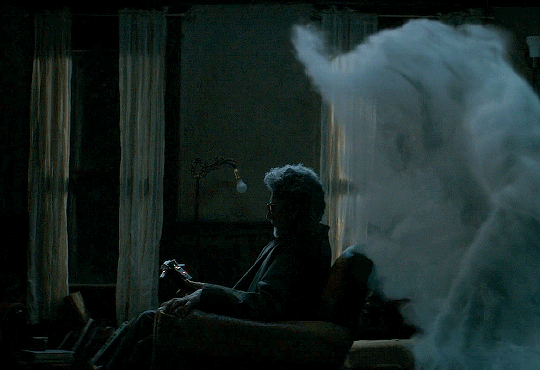
Cinematography by Eric Steelberg, Screenplay by Jason Reitman and Gil Kenan, Music by Rob Simonsen. Starring Mckenna Grace as Phoebe, Finn Wolfhard as Trevor, Logan Kim as Podcast, Carrie Coon as Callie, and Paul Rudd as Gary Grooberson.
#west side story 2021#last night in soho#zack snyders justice league#restorethesnyderverse#2021#ghostbusters afterlife
10 notes
·
View notes
Text
DANNY KAYE
January 18, 1911

Danny Kaye was born David Daniel Kaminsky in Brooklyn, New York, in 1911, although he would later claim 1913. A multi-talented performer, he was an actor, singer, dancer, comedian, and musician. A high school drop-out, Kaye's first break came in 1933 when he joined a vaudeville dance act that toured the United States and Asia.

Kaye's film debut came in 1937 with a series of low-budget shorts. The series ended when the studio shut down in 1938.

On Broadway, Kaye appeared in The Straw Hat Revue (1939), Lady in the Dark (1941, above center), and Let's Face It! (1941).

After a significant absence, Kaye returned to Broadway in 1970 to play Noah in the musical Two By Two. When he broke his leg, he performed the role in a cast using a crutch!

Kaye’s first time on television was also his first time appearing with Lucille Ball: “The 24th Annual Academy Awards.”
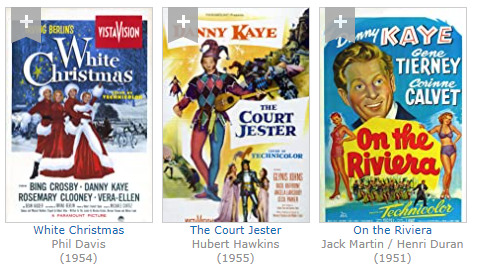
Some of Kaye’s best-loved motion pictures include White Christmas (1954), The Court Jester (1955), and On the Riviera (1951). In 1955, he was given an honorary Oscar for “his unique talents, his service to the Academy, the motion picture industry, and the American people.” In 1980, he was the recipient of the Academy’s Jean Hersholt Humanitarian Award.
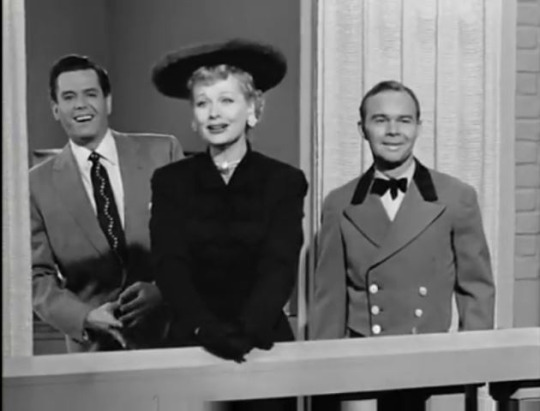
Although Kaye never appeared on “I Love Lucy” he was mentioned in the dialogue. “Lucy Meets the Queen” (ILL S5;E15) was doubtless inspired by Danny Kaye’s November 1948 Command performance for King George and Princess Elizabeth at the Palladium Theatre.
Lucy (to the Bellboy): Have you ever seen the Queen?
Bellhop: No, ma'am. But I came frightful close during the coronation. I just missed her. But I did catch a glimpse of him.
Lucy: Philip?
Bellhop: No, ma'am. Danny Kaye.
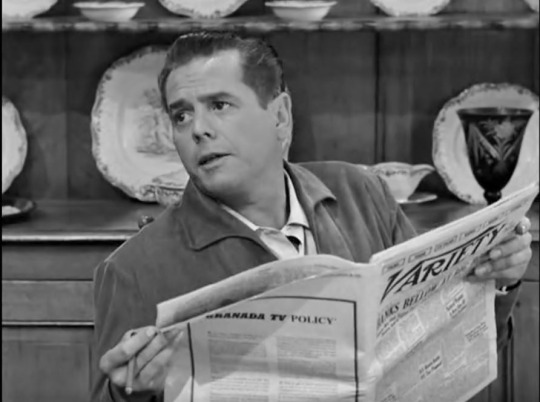
In a 1959 episode of “The Lucy–Desi Comedy Hour” Lucy complains about how many meals she’s cooked as a housewife:
Ricky (reading Variety): It says here that Danny Kaye is going to London to give another command performance for Queen Elizabeth.
Lucy: I wonder what the Queen is cooking for Phil tonight?

In 1960, Kaye signed a $1.5 million contract for three annual specials that would set the pattern for his later series. Lucille Ball joined him for “The Danny Kaye Show” on November 11, 1962. Because it was the first television teaming of the two famous redheads, the special was hailed as “A Television First” and was also Lucille Ball’s first appearance in color.

Lucille Ball sang, danced the Twist, and did imitations of Judy Garland, Carol Channing, and Marlene Dietrich. The highlight of the special was undoubtedly their three-part sketch about the trend of internationally themed restaurants.

Two years later, on November 4, 1964, Ball made a second appearance on the program.

Without the use of costumes or scenery, Kaye and Lucille Ball performed a sketch about a married couple forced to fire a maid who is monopolizing the care of their baby.

Danny Kaye and Lucille Ball performed “The Balloonists,” which included making playful noises with the balloons as they sing and dance, ultimately popping every balloon on the stage.

The next sketch imagines what would happen if a snowstorm kept all but two actors in a traveling troupe from arriving at the theatre to perform a Victorian melodrama. It turns into a quick change act for the two actors.

On December 28, 1964, Kaye repaid the favor by appearing on “The Lucy Show” in “Lucy Meets Danny Kaye” (S3;E15). Kaye played himself, and Lucy Carmichael was her usual star-struck self!

In November 1965, Lucy and Danny were two of the performers on tap for a “Salute To Stan Laurel” who had died earlier in the year. The two have no scenes together.

In November 1976, Kaye contributed to “CBS Salutes Lucy: The First 25 Years”. Kaye talks about Lucy’s skill at physical comedy.
Kaye: “Calling Lucille Ball 'just’ a comedian is like calling Margot Fonteyne 'just’ a dancer.”
In 1985, Lucy and Danny were two of the celebrities in “Night of 100 Stars II” at Radio City Music Hall.

In February 1986, Kaye made his final screen appearance as a Dentist on “The Cosby Show”. The role got him nominated for an Emmy Award, although he lost to Roscoe Lee Brown for a guest shot on the same series. Coincidentally, Lucille Ball was a presenter at “The 38th Annual Primetime Emmy Awards”.
Kaye married Sylvia Fine in January 1940. They had one child (Dena) and were together until he died of heart failure on March 3, 1987, aged 76.
“Life is a great big canvas; throw all the paint you can at it.” ~ Danny Kaye

#Danny Kaye#Lucille Ball#The Danny Kaye Show#The Lucy Show#Sylvia Fine#The Cosby Show#desi arnaz#Broadway#Two By Two#Cupid Takes A Holiday#Lady in the Dark#TV#Film
8 notes
·
View notes
Photo


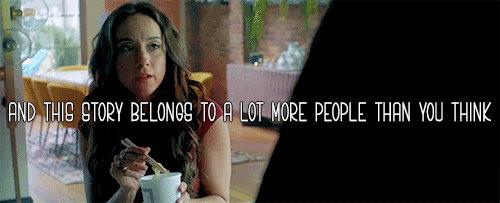

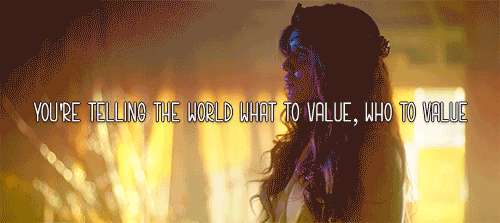
Happy International Women’s Day
to all the female-identifying people!
As we could not put everyone on the gifset, we also want to shout out to all the woman inside and outside the show
Character in the show: Callie, Camille, Carol, Cindy Gaines, Copy Girl, Crying Woman, Dr. Jennifer London, Dragon, Emily Greenstreet, Etta, Eve, Female Professor, Fray, Genji, Gretchen, Harriet, Healer Faye, Hedge #1, Homicide Detective #1, Irene McAllistair, Iris, Kimber D'Antoni, Kira, Lia, Librarian Rona, Mackenzie, Old Woman, Orgy Girl #1, Orgy Girl #2, Phyllis, Prof. Pearl Sunderland, Poppy, Professor Bigby, Psychic Girl #2, Rainbow Girl, Receptionist, Sam Cunningham, Shelia, Stone Queen, Sylvia, The Prophet, The White Lady, Whitley, Young Hedge, AD, Arielle, Arleen, Ashley the Bookie, Baba Yaga (and the girl she posess), Beatrice McAllister,Beatrix, Becky, Dana, Doctor Meers, Dr. Higgins, Evelyn,Fairy Queen, Fillorian Mother, Goldie, Hanna, Harriet, Healer Tara, Heloise,Homeless Lady, Jane Chatwin,Marina Andrieski,Mellony, Napster, Natural Student #1,Nurse#1, Nurse#2, Persephone, Physical Kid #1, Poppy, Professor Lipson, Prudence Plover, Quentin's Mother, Rhona, Scared Woman 36,Shara,Shoshana, Silver, Skye, Sonia 36, Spectre, Stephanie Quinn, Stephanie's Friend, Suzie, TV Crew, Victoria, Water Dragon,Zal, Zelda and all uncredited characters!
off cameras woman : Adela Baborova, Aeryn Gray, Alexandra Rojek, Allison Gordin, Alma Kuttruff, Alyssa Jacobson, Amber Crombach, Amber Waters, Ana Lossada, Ana Lossada, Angie Kennedy, Anna Register, Annalese Tilling, Anne Grennan, Ashley Biggs, Ashley Mason, Athena Wong,Audrey Himmer-Jude, Aylwin Fernando, Barbara Jansen, Beth Williams, Blair Richmond, Blythe Bickham, Breanna Watkins, Bree Brincat, Briana Skye, Brittney Diez, Caitlin Groves, Candice Harvey, Cara Doell, Carmen Lavender, Carole Appleby, Caroline Milliard, Carolyn McCauley, Carolyn Williams,Carrie Audino ,Cassandra Parigian, Cathy Darby, Chere Theriot, Cherie Bessette, Cherie Smid, Cheryl Callihoo, Christina Nakhvat, Clara George, Clarinda Wong, Coreen Mayrs, Crystal Mudry, Danielle White, Debbie Douglas, Deborah Burns, Deborah Burns, Deneen McArthur, Denya McLean-Adhya, Desiree J. Cadena, Donna Stocker, Elie Smolkin, Elizabeth Rainey, Elle Lipson, Emily Nomland, Emily Upham, Emily Weston, Emmanuelle Charlier, Errin Clutton, Eunice Yeung, Eva Abramycheva, Gilda Longoria, Ginge Cox, Grace Delahanty, Heike Brandstatter, Helen Geier, Irina Berdyanskaya, Irwin Figuera, Janene Carleton, Janet D. Munro, Janice MacIsaac,Janice Williams, Jayne Dancose, Jenni Macdonald, Jennifer Gilevich, Jennifer Kaminski, Jennifer Machnee, Jennifer Nelson, Jesse Toves, Jessica Goodwin, Jessica Williams, Juli Van Brown, Julia Holt, June E. Watson, Justin Coulter, Kai Lesack, Kara Bowman, Karen Lorena Parker, Karina Partington, Karley Stroscher, Karly Paranich, Kate Marshall, katerina Motylova, Kathie Singh, Katie Letien, Katrissa 'Kat' Peterson, Kelli Dunsmore, Kendelle Elliott, Kristy Jelinek, Kyla Rose Tremblay, Kyle Landry, Laura Dickinson, Laura Schiff, Lauren Aspden, Lauren Beason, Laurie Lieser, Leslie Cairns, Lisa Blaxley, Lisa Chandler, Lisa Godwin, Lisa Pouliot, Lisa Pouliot, Lisle Fehlauer, Liz Goldwyn, Lucie Elwes, Luisa Abuchaibe, Lyne Talbot, Lynn Werner, Madeline Jensen, Madison Mah, Madison Penland, Magali Guidasci, Maisie Lucas, Margot Ready, Maria Gleeson, Marie Marolle, Marijke Richman, Martha Dietsche, Mary Hubert, Meghan Kelly, Michelle Kabatoff, Michelle Kee, Michelle Yu, Miluette Nalin, Mimi Dejene, Nadia Alaskari, Natasha Wehn, Nicole Bivens, Nina Göldner, Patricia Jagger, Patti Henderson, Paula Antil, Polina Nikolai, Pricilla Rodgers,Priya Ayengar, Rachel O'Toole,Rita K. Sanders, Rudy Jones, Sam Ochotta, Sarah McLauchlan, Sera Gamble, Shae Salmon, Shae Salmon, Shailey Horton, Shannon Courte, Shannon Kohli, Shannon McArthur, Sharon Dever, Shelly Goldsack, Shelly Shaw, Sina Nazarian, Sondra Durkse, Sonia V. Torres, Sophia Delgiglio, Stephane Bourgeault, Stephanie Plett, Sue Blainey, Sumner Boissiere III, Sunil Pant, Taja Perkins, Tamara Daroshin, Teresa Brauer, Tracey McLean,Tracie Hansen, Tracie Leaphart, Tracy Craigen, Vanja Cernjul, Wendy Foster, Wendy Snowdon, Wendy Talley
(Source IMDB)
984 notes
·
View notes
Text
SEASON 3 FACECLAIMS/ACTORS:

MAIN CAST
Curtis Kaminski (director)- Logan Lerman
Moxie Hart (stage manager)- Emily Hampshire
Artemis “Art” Musica (producer)- Me!!
Bradford “Brad” Armstrong (choreographer)- Grey Henson

SUPPORTING
Sledge Larkin, Moxie’s fiancee- Chris Pratt
Stellan The Gay Vocal Coach (MD)- Titus Burgess
Miss Lilllith Jenna McKenzie Jackson- Megan Mulally

Jackie Musica (Art’s mom)- Jane Krakowski
Robert Musica (Art’s dad)- Jack McBrayer

GUEST STARS
Will Arnett and Chris Parnell as Harold and Tim, two playbill hoarders that have stolen a bunch of the troupe’s leftover playbills.

Taylor Louderman, Barrett Wilbert Weed, Alex Brightman, and Aaron Tveit all play themselves when the troupe attends BroadwayCon.

Tina Fey, Alec Baldwin, Tracy Morgan, and Scott Adsit all play themselves in the episode where Art wins a tour of 30 rock.

Christian Borle plays Chip, a rich broadway star who comes to town to give a workshop- and intertwines with the cast of “Legally Blonde”
Bette Midler plays Curtis’ stern mom, Alice
Frankie Muniz plays Grant, an architect that Curtis calls to help build set for “Legally Blonde”.

Laura Bell Bundy plays herself in the Season 3 Finale, whom shows up to the final performance of “Legally Blonde”, as she says “she tries to see as many productions of the show as she can, since she originated Elle.”
Jeremy Jordan returns as Jeremy, Brad’s choir director boyfriend.

SHOW WITHIN A SHOW CAST (LEGALLY BLONDE)
Amanda Seyfried as Elle Woods
Matt Doyle as Emmett Forrest
Zachary Levi as Warner Huntington III
Krysta Rodriguez as Vivienne Kensington
Eva Noblezada as Serena
Raven Simone as Pilar
Kate Rockwell as Margot
3 notes
·
View notes
Text
Technological 'Disruption' of the Law's Imagined Scene: Some Lessons from Lex Informatica by Margot E. Kaminski :: SSRN
0 notes
Text
0 notes
Text
We’re constantly generating ‘shadow’ medical records
We all have official medical records, locked away in the computers and file cabinets of our doctors’ offices and hospitals, protected by strict privacy laws. But we also have the informal “shadow” records we generate just by living our lives.
In a new article in Science, a team of experts calls for attention to this shadow record.
They describe it as the data generated by everyone who wears a fitness tracker, uses a smartphone health app, shops for health-related items—or really, almost anything—online or with a customer loyalty card, orders DNA tests to learn about their genetic disease risk or ancestry, searches the internet for health information, or posts on social media or other sites about their health.
When academic researchers or industry pool together and use shadow-record elements, they can fuel progress in health care research and innovation, say team leader Nicholson Price, assistant professor of law at the University of Michigan, and coauthors.
In fact, he and his colleagues say companies have already started gathering and selling access to massive amounts of such data. But, they say, few rules apply to the storage and use of shadow data—and the protection of the people behind the data.
Meanwhile, some academic researchers already study bulk data from official medical records—after it’s been stripped of individual identification. That kind of study, called health services research, has fueled many improvements in care and policy.
Price and Kayte Spector-Bagdady, an assistant professor at the University of Michigan Medical School and member of the university’s Center for Bioethics & Social Sciences in Medicine, reviewed the current laws and regulations surrounding shadow medical records.
“Not all industry involvement in health data is a bad thing,” Spector-Bagdady says. “Industry can help propel innovation. But relying on loopholes to collect personal health data without knowledge is predatory.”
She and Price worked with Margot Kaminski, an associate professor of law from the University of Colorado, and Timo Minssen, director of the Center for Advanced Studies in Biomedical Innovation Law at the University of Copenhagen.
They call for better clarity in current regulations, to make sure research in the public interest can go forward. And they recommend that any future data privacy-related hearings, legislation, and regulations should pay special attention to health-related topics.
‘Black box’ algorithms
Price has also written recently about another area of data-drive health innovation that he says needs more transparency.
Called “black box” algorithms, they’re a burgeoning type of artificial intelligence software that harnesses large-scale medical data to give doctors, other health providers, or consumers advice on health topics.
“Privacy underprotection and overprotection each create cognizable harms to patients both today and tomorrow.”
They’re based on machine learning, which feeds massive amounts of data into computerized systems and teaches them to recognize and predict patterns.
For instance, using data about lung cancer risk from thousands of patients, an algorithm could help doctors decide which patients should go for chest CT scans to see if they have early signs of lung cancer, and which aren’t as likely to benefit from such screening.
Writing in Science Translational Medicine, Price describes the potential value of these algorithms in predicting the course of disease, or augmenting the skills of radiologists and pathologists in reading scans and tissue samples from patients.
But he also notes that guidelines for the clinical use and regulation of such tools need to be developed now, including standards for validating the tools’ actual usefulness.
More transparency by industry about the data and assumptions used in making their black boxes could help increase the chance that providers will opt to use the tools—and that regulators would not crack down on them in a way that limits their use.
Rather, he argues, the medical algorithm sector needs regulatory flexibility, transparency, and broad involvement by different sectors of the health system including researchers, providers, and regulators.
“Big data and AI are racing ahead in medicine,” Price says. “And right now, law and policy are playing catch-up.”
Too much privacy?
Price also wrote a review article in Nature Medicine with I. Glenn Cohen of Harvard University’s Petrie-Flom Center for Health Law Policy, Biotechnology, and Bioethics. In it, they look at many legal and ethical aspects of the rise of big data, artificial intelligence, machine learning, and other data-driven technologies in medicine.
They call for a balance between maximizing the potential development and use of such tools, and protecting the privacy of those whose medical and shadow data would be used anonymously to build and test the tools.
“It is important that we not assume privacy maximalism across the board is the way to go,” Price and Cohen write. “Privacy underprotection and overprotection each create cognizable harms to patients both today and tomorrow.”
Source: University of Michigan
The post We’re constantly generating ‘shadow’ medical records appeared first on Futurity.
We’re constantly generating ‘shadow’ medical records published first on https://triviaqaweb.weebly.com/
0 notes
Text
:@WilliamBaude: Is a Privacy Violation an "Injury"?
The Supreme Court's call for supplemental briefing in Frank v. Gaos will lead it to a difficult question.
Last week, the Supreme Court heard oral argument in an interesting and important class action case, Frank v. Gaos, about when lawyers can agree to settle a case on behalf of a class action by giving all of the money to a charity instead of the class. Today, however, the Supreme Court called for supplemental briefing on a different question -- whether the named plaintiffs have suffered an "injury" sufficient to create standing under the Court's doctrine. That question may prove to be even trickier.
The plaintiffs in Gaos complain that Google has unlawfully turned over information about their search histories. Before the Supreme Court's decision in Spokeo v. Robins, some circuits, including the Ninth Circuit, had concluded that any violation of an individual statutory right was enough for standing. As the cases said, "Congress may enact statutes creating legal rights, the invasion of which creates standing, even though no injury would exist without the statute." In Spokeo, the Court concluded that that formulation was incomplete, and that the right must also be "concrete" though it could nonetheless be "intangible."
During the Frank oral argument, some justices became concerned that the plaintiffs in Gaos might not have standing, because they may have alleged little more than the illegal disclosure of their private search histories. While the justices batted around the possibility of a remand, the request for supplemental briefing suggests that the Court will decide the standing issue on its own.
Doing so, however, will require the Court to decide a somewhat tricky question about the nature of standing in privacy cases. Is the disclosure of previously private information itself a concrete injury? Or must the plaintiff allege that somebody else used that information against them in a particular way? Indeed, this is one of the tricky things about the Spokeo decision itself. Margot Kaminski and Matthew DeLuca have articles about standing for privacy claims after Spokeo. And as I wrote in an article last year about Spokeo:
For instance, last summer the D.C. Circuit confronted a lawsuit by two D.C. shoppers who complained that local clothing stores had demanded their zip codes in violation of local law. Without disputing that the information was illegally demanded, D.C. Circuit dismissed the case for lack of standing. The forced disclosure of one's zip code, it held, was not a concrete injury after Spokeo. In Spokeo the Court had offered a coincidentally similar example, writing: "not all inaccuracies cause harm or present any material risk of harm. An example that comes readily to mind is an incorrect zip code. It is difficult to imagine how the dissemination of an incorrect zip code, without more, could work any concrete harm."
The D.C. Circuit found the dictum apt, writing, "If, as the Supreme Court advised, disclosure of an incorrect zip code is not a concrete Article III injury, then even less so is [the plaintiffs'] naked assertion that a zip code was requested and recorded without any concrete consequence. [The plaintiffs] do not allege, for example, any invasion of privacy, increased risk of fraud or identity theft, or pecuniary or emotional injury."
This is probably the correct conclusion to draw from Spokeo's somewhat gratuitous discussion of zip codes, but at a more fundamental level it again suggests that something is wrong with Spokeo. Why must the plaintiffs show something like a risk of identity theft or emotional injury to demonstrate a concrete injury? Why can't an illegal disclosure itself be a concrete injury? As to a zip code, this may seem strange. But imagine that the illegal disclosure was something else--an unflattering photograph or email, perhaps. Surely this ought to be actionable without showing a subsequent consequence, like the loss of one's job or social standing. Or, more modestly, imagine somebody who is embarrassed by their middle name and does not wish to see it disclosed. If that person has a legal right against disclosure, why should they need anything more?
There are two possible ways to resolve the scope of privacy laws in light of the courts' position on zip codes. One possibility, the more aggressive one, is to conclude that illegal disclosure of facts about oneself is never itself a concrete injury. To sue over the disclosure of one's address, photos, name, or anything else, one would have to demonstrate some sort of downstream consequences from these disclosures. In other words, privacy itself would not be a protectable interest under Article HI. This position has a certain logical purity, but one hopes that it is too implausible even for today's courts to adopt. It would mean that even injuries recognized under long-standing common law principles would not be enough to satisfy the "injury in fact" requirement.
The alternative possibility, a more modest one, is that some illegal disclosures are injurious in themselves, and others are not. For instance, perhaps the disclosure of photographs is different in kind from the disclosure of zip codes, even if both are protected by legal right. (The D.C. Circuit's attempt to distinguish "invasion of privacy" as an actionable "concrete consequence" might point to this possibility.) There is some common sense intuition behind this approach, but it is not entirely principled. If the legislature has made the judgment to protect both kinds of information, it is not at all clear why judges may decide that one is "concrete," that is, "real," and the other is not. This saves some of privacy law from Spokeo only by creating a constitutional common law of privacy interests.
What is more, the question of when the illegal disclosure of information is a concrete injury is one that appears to have divided lower courts in the short time since Spokeo. So, in order to deny standing (and perhaps in order to grant it) the Court may have to resolve another circuit split beyond the one that it originally granted the case to resolve.
This makes me a little nervous, since I do not think the Court does its best work on tricky federal courts questions when they are noticed at the last minute in the middle of another merits case. The posture also means that the issue may not get as much public attention (and I am not even sure whether amicus briefs are permitted on this issue -- though surely there would have been many if the issue were granted in another case).
Still, having concluded that there was a real jurisdictional question, the justices do have an obligation to do their best to resolve it. And asking for supplemental briefing may be the most responsible thing they can do at this point.
0 notes
Text
Platform Censorship: Lessons From the Copyright Wars
There’s a lot of talk these days about “content moderation.” Policymakers, some public interest groups, and even some users are clamoring for intermediaries to do “more,” to make the Internet more “civil,” though there are wildly divergent views on what that “more” should be. Others vigorously oppose such moderation, arguing that encouraging the large platforms to assert and ever-greater role as Internet speech police will cause all kinds of collateral damage, particularly to already marginalized communities.
Notably missing from most of these discussions is a sense of context. Fact is, there’s another arena where intermediaries have been policing online speech for decades: copyright. Since at least 1998, online intermediaries in the US and abroad have taken down or filtered out billions of websites and links, often based on nothing more than mere allegations of infringement. Part of this is due to Section 512 of the Digital Millennium Copyright Act (DMCA), which protects service providers from monetary liability based on the allegedly infringing activities of third parties if they “expeditiously” remove content that a rightsholder has identified as infringing. But the DMCA’s hair-trigger process did not satisfy many rightsholders, so large platforms, particularly Google, also adopted filtering mechanisms and other automated processes to take down content automatically, or prevent it from being uploaded in the first place.
As the content moderation debates proceed, we at EFF are paying attention to what we learned from two decades of practical experience with this closely analogous form of “moderation.” Here are a few lessons that should inform any discussion of private censorship, whatever form it takes.
1. Mistakes will be made—lots of them
The DMCA’s takedown system offers huge incentives to service providers that take down content when they get a notice of infringement. Given the incentives of the DMCA safe harbors, service providers will usually respond to a DMCA takedown notice by quickly removing the challenged content. Thus, by simply sending an email or filling out a web form, a copyright owner (or, for that matter, anyone who wishes to remove speech for whatever reason) can take content offline.
Many takedowns target clearly infringing content. But there is ample evidence that rightsholders and others abuse this power on a regular basis—either deliberately or because they have not bothered to learn enough about copyright law to determine whether the content they object to is unlawful. At EFF, we’ve been documenting improper takedowns for many years, and highlight particularly egregious ones in our Takedown Hall of Shame.
As we have already seen, content moderation practices are also rife with errors. This is unlikely to change, in part because:
2. Robots aren’t the answer
Rightsholders and platforms looking to police infringement at scale often place their hopes in automated processes. Unfortunately, such processes regularly backfire.
For example, YouTube’s Content ID system works by having people upload their content into a database maintained by YouTube. New uploads are compared to what’s in the database and when the algorithm detects a match, copyright holders are informed. They can then make a claim, forcing it to be taken down, or they can simply opt to make money from ads put on the video.
But the system fails regularly. In 2015, for example, Sebastien Tomczak uploaded a ten-hour video of white noise. A few years later, as a result of YouTube’s Content ID system, a series of copyright claims were made against Tomczak’s video. Five different claims were filed on sound that Tomczak created himself. Although the claimants didn’t force Tomczak’s video to be taken down they all opted to monetize it instead. In other words, ads on the ten-hour video could generate revenue for those claiming copyright on the static.
Third party tools can be even more flawed. For example, a “content protection service” called Topple Track has been sending a slew of abusive takedown notices to have sites wrongly removed from Google search results. Topple Track has boasted that it was “one of the leading Google Trusted Copyright Program members.” In practice, Topple Track algorithms were so out of control that it sent improper notices targeting an EFF case page, the authorized music stores of both Beyonce and Bruno Mars, a New Yorker article about patriotic songs. Topple Track even sent an improper notice targeting an article by a member of the European Parliament that was about improper automated copyright notices.
So if a platform tells you that it’s developing automated processes that will target only “bad” speech, at scale, don’t believe them.
3. Platforms must invest in transparency and robust, rapid, appeals processes
With the above in mind, every proposal and process for takedown should include a corollary plan for restoration. Here, too, copyright law and practice can be instructive. The DMCA has a counternotice provision, which allows a user who has been improperly accused of infringement to challenge the takedown and, if the sender doesn’t go to court, the platform can restore to content without fear of liability. But the counternotice process is pretty flawed: it can be intimidating and confusing, it does little good where the content in question will be stale in two weeks, and platforms are often even slower to restore challenge material. One additional problem with counter-notices, particularly in the early days of the DMCA, was that users struggled to discover who was complaining, and the precise nature of the complaint.
The number of requests, who is making them, and how absurd they can get has been highlighted in company transparency reports. Transparency reports can both highlight extreme instances of abuse—such as in Automattic’s Hall of Shame—or share aggregate numbers. The former is a reminder that there is no ceiling to how rightsholders can abuse the DMCA. The latter shows trends useful for policymaking. For example, Twitter’s latest report shows a 38 percent uptick in takedowns since the last report and that 154,106 accounts have been affected by takedown notices. It’s valuable data to have to evaluate the effect of the DMCA, data we also need to see what effects “community standards” would have.
Equally important is transparency about specific takedown demands, so users who are hit with those takedowns can understand who is complaining, about what. For example, a remix artist might include multiple clips in a single video, believing they are protected fair uses. Knowing the nature of the complaint can help her revisit her fair analysis, and decide whether to fight back.
If platforms are going to operate as speech police based on necessarily vague “community standards” they must ensure that uses can understand what’s being taken down, and why. They should do so on a broad scale by being open about their takedown processes and the results. And then they should put in place clear, simple procedures for users to challenge takedowns, that don’t take weeks to complete.
4. Abuse should lead to real consequences
Congress knew that Section 512’s powerful incentives could result in lawful material being censored from the Internet without prior judicial scrutiny. To inhibit abuse, Congress made sure that the DMCA included a series of checks and balances, including Section 512(f), which gives users the ability to hold rightsholders accountable if they send a DMCA notice in bad faith.
In practice, however, Section 512(f) has not done nearly enough to curb abuse. Part of the problem is that the Ninth Circuit Court of Appeals has suggested that the person whose speech was taken down must prove to a jury the subjective belief of the censor—a standard that will be all but impossible for most to meet, particularly if they lack the deep pockets necessary to litigate the question. As one federal judge noted, the Ninth Circuit’s “construction eviscerates § 512(f) and leaves it toothless against frivolous takedown notices.” For example, some rightsholders unreasonably believe that virtually all uses of copyrighted works must be licensed. If they are going to wield copyright law like a sword, they should at least be required to understand the weapon.
“Voluntary” takedown systems could do better. Platforms should adopt policies to discourage users from abusing their community standards, especially where the abuse is obviously political (such as flagging a site simply because you disagree with the view expressed).
5. Speech regulators will never be satisfied with voluntary efforts
Platforms may think that if they “voluntarily” embrace the role of speech police, governments and private groups will back off and they can escape regulation. As Professor Margot Kaminski observed in connection with the last major effort push through new copyright enforcement mechanisms, voluntary efforts never satisfy people speech censors:
Over the past two decades, the United States has established one of the harshest systems of copyright enforcement in the world. Our domestic copyright law has become broader (it covers more topics), deeper (it lasts for a longer time), and more severe (the punishments for infringement have been getting worse).
… We guarantee large monetary awards against infringers, with no showing of actual harm. We effectively require websites to cooperate with rights-holders to take down material, without requiring proof that it's infringing in court. And our criminal copyright law has such a low threshold that it criminalizes the behavior of most people online, instead of targeting infringement on a true commercial scale.
In addition, as noted, the large platforms adopted a number of mechanisms to make it easier for rightsholders to go after allegedly infringing activities. But none of these legal policing mechanisms have stopped major content holders from complaining, vociferously, that they need new ways to force Silicon Valley to be copyright police. Instead, so-called “voluntary efforts end up serving as a basis for regulation. Witness, for example, the battle to require companies to adopt filtering technologies across the board in the EU, free speech concerns be damned.
Sadly, the same is likely to be true for content moderation. Many countries already require platforms to police certain kinds of speech. In the US, the First Amendment and the safe harbor of CDA 230 largely prevent such requirements. But recent legislation has started to chip away at Section 230, and many expect to see more efforts along those lines. As a result, today’s “best practices” may be tomorrow’s requirements.
The content moderation debates are far from over. All involved in those discussions would do well to consider what we can learn from a related set of debates about the law and policies that, as a practical matter, have been responsible for the vast majority of online content takedowns, and still are.
from Deeplinks https://ift.tt/2OSBEq4
0 notes
Text
Watch THR's Full Cinematographer Roundtable With Talent From 'Blade Runner 2049,' 'Dunkirk,' 'Mudbound,' and More on SundanceTV
https://styleveryday.com/2018/02/22/watch-thrs-full-cinematographer-roundtable-with-talent-from-blade-runner-2049-dunkirk-mudbound-and-more-on-sundancetv/
Watch THR's Full Cinematographer Roundtable With Talent From 'Blade Runner 2049,' 'Dunkirk,' 'Mudbound,' and More on SundanceTV
5:45 AM PST 2/22/2018
by
THR Staff
Roger Deakins, Robert Elswit, Janusz Kaminski, Dan Laustsen, Rachel Morrison and Hoyte Van Hoytema joined THR’s Cinematographer Roundtable.
The lensing experts behind Blade Runner 2049, Dunkirk, Mudbound, The Post, Roman J. Israel, Esq., The Shape of Water and Suburbicon open up about their craft and finding a balance with their directors: “He does his thing, I do my thing. Somehow we both see this movie the same way.”
Viewers can watch the roundtable discussions Sundays on SundanceTV as part of the cable channel’s original nonfiction series, Close Up With The Hollywood Reporter, produced in partnership with THR. Come back to THR.com on Mondays after the shows air for the full, uncensored discussion online.
The sixth of seven episodes — the Cinematographer Roundtable — airs this Sunday, Feb. 25. For subsequent episodes, tune in every Sunday at 10 a.m. ET/7 a.m. PT on satellite (channel 557 on DirecTV and 126 on Dish nationwide), and at 10 a.m. ET/PT on cable (channel 625 on Spectrum/TWC in L.A., 94 in NYC).
The filmed roundtable panels feature this year’s top filmmakers including directors, actors and actresses, producers, screenwriters, and cinematographers. Guests will discuss everything from their individual projects to their craft and true stories from the business. The panels will present thoughtful, informative takes on the film and television industry today.
The complete schedule for the season is as follows:
Sunday, Jan. 21: Director Roundtable
Guillermo del Toro (Shape of Water)
Greta Gerwig (Lady Bird)
Patty Jenkins (Wonder Woman)
Angelina Jolie (First They Killed My Father)
Denis Villeneuve (Blade Runner 2049)
Joe Wright (Darkest Hour)
Sunday, Jan. 28: Actor Roundtable
John Boyega (Detroit)
Willem Dafoe (The Florida Project)
James Franco (The Disaster Artist)
Tom Hanks (The Post)
Gary Oldman (Darkest Hour)
Sam Rockwell (Three Billboards Outside Ebbing, Missouri)
Sunday, Feb. 4: Actress Roundtable
Mary J. Blige (Mudbound)
Jessica Chastain (Molly’s Game)
Allison Janney (I, Tonya)
Jennifer Lawrence (mother!)
Saoirse Ronan (Lady Bird)
Emma Stone (Battles of the Sexes)
Sunday, Feb. 11: Producer Roundtable
Judd Apatow (The Big Sick)
Jason Blum (Get Out)
Eric Fellner (Darkest Hour, Baby Driver, Victoria and Abdul)
Amy Pascal (The Post, Molly’s Game)
Seth Rogen (The Disaster Artist)
Ridley Scott (All the Money in the World, Blade Runner 2049)
Sunday, Feb. 18: Writer Roundtable
Fatih Akin (In the Fade)
Darren Aronofsky (mother!)
Emily V. Gordon (The Big Sick)
Anthony McCarten (Darkest Hour)
Jordan Peele (Get Out)
Aaron Sorkin (Molly’s Game)
Sunday, Feb. 25: Cinematographer Roundtable
Roger Deakins (Blade Runner 2049)
Robert Elswit (Suburbicon, Roman J. Israel, Esq.)
Janusz Kaminski (The Post)
Dan Laustsen (The Shape of Water)
Rachel Morrison (Mudbound)
Hoyte Van Hoytema (Dunkirk)
Sunday, March 4: Actors Live Roundtable
Bryan Cranston (Last Flag Flying)
Armie Hammer (Call Me By Your Name)
Diane Kruger (In the Fade)
Robert Pattinson (Good Time)
Margot Robbie (I, Tonya)
Octavia Spencer (The Shape of Water)
Sundance TV’s HD Channels (for national providers):
AT&T U-verse 1798
Verizon FIOS 735
DirecTV 557
DISH 126
PGM.createScriptTag("//connect.facebook.net/en_US/sdk.js#xfbml=1&version=v2.6&appId=303838389949803");
0 notes
Link
0 notes
Text
New from richards1000... Authorship, Disrupted: AI Authors in Copyright and First Amendment Law by Margot Kaminski :: SSRN
Authorship, Disrupted: AI Authors in Copyright and First Amendment Law by Margot Kaminski :: SSRN
from richards1000 http://liicr.nl/2nTwalZ
via IFTTT
0 notes
Link
0 notes
Text
16:00 - BODIES OF EVIDENCE: STRONG POINTS AND DRAWBACKS OF THE GDPR BETWEEN US AND EU
Academic*** Policy***
Organized by University of Turin
Chair Shara Monteleone EU Parliament (EU)
Moderator Ugo Pagallo, University of Turin (IT)
Speakers Konstantinos Karachalios, IEEE (INT); Argyro Karanasiou, Bournemouth University (UK); Alessandro Spina, EU EMA (EU); Marc Rotenberg, EPIC (US); Margot Kaminski, University of Colorado (US)
Crucial differences exist and persist between the US and EU regulations in the field of privacy and data protection. Yet, we could also say that such legal systems are separated by common goals. The aim of the panel is to shed further light on these differences and commonalities some weeks before the GDPR's direct applicability, by examining both the qualities and drawbacks of the new EU legal framework. Divergent judgements may of course hinge on different legal cultures. Still, diverse opinions may also depend on how we interpret some crucial rules and provisions of the GDPR: the latter can be understood either as a toothless mechanism or as a powerful means to safeguard the data subjects. The wording of the regulation allows either to be true. Four crucial issues follow as a result:
Will the GDPR amplify, or decrease, crucial differences between the US and EU regulations in the field of privacy and data protection?
What are the strongest and weakest parts of the GDPR according to (also, but not only) a US viewpoint?
What can the US legal system learn from the GDPR? Can GDPR alignment borrow from US best practices?
0 notes